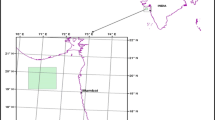Abstract
We present a method for detecting oil spills in a complex scene of SAR imagery, including segmenting oil spills, and avoiding false alarms. Segmentation is carried out using a multi-time and multi-hierarchical method by dividing the complex sea surface into bright sea and dark sea. Gray-based and edge-based segmentations are done to extract oil spills from bright and dark sea, respectively. The proposed method can extract complete oil spills, obtain better visual results, and increase detection probability more accurately than the traditional method. Based on the surrounding features and the oil spills’ features, dark land spots and low contrast dark spots are removed efficiently, thus reducing false alarms. The experimental results demonstrate that the proposed algorithm has fast computation speed, high detection accuracy, and is very useful and effective for detecting oil spills in SAR imagery.
Similar content being viewed by others
References
Chen Y, Zhang R, Yin D. Multi-polarimetric SAR image compression based on sparse representation. Sci China Inf Sci, 2012, 55: 1888–1897
Xu G, Sheng J L, Zhang L, et al. Performance improvement in multi-ship imaging for ScanSAR based on sparse representation. Sci China Inf Sci, 2012, 55: 1860–1875
Sheng J L, Zhang L, Xu G, et al. Coherent processing for ISAR imaging with sparse apertures. Sci China Inf Sci, 2012, 55: 1898–1909
Xiao Z, Yu S M, Shi H. A brief of recent research progress on ionospheric disturbances. Sci China Inf Sci, 2013, 56: 122304 (9)
Solberg A H S. Remote sensing of ocean oil-spill pollution. Proc IEEE, 2012, 100: 2931–2945
Shirvany R, Chabert M, Tourneret J Y. Ship and oil-spill detection using the degree of polarization in linear and hybrid/compact dual-pol SAR. IEEE J Sel Topics Appl Earth Observ Rem Sens, 2012, 5: 885–892
Li H Y, Perri W. An analysis of the polarimetric scattering properties of oil spills on the ocean surface with hybrid polarimetry SAR. In: IEEE International Geoscience and Remote Sensing Symposium (IGARSS), 2013. 302–305
Salberg A B, Rudjord O, Solberg A H S. Oil spill detection in hybridpolarimetric SAR Images. IEEE Trans Geosc Rem Sens, 2014, 99: 1–13
Barni M, Betti M, Mecocci A. A fuzzy approach to oil spill detection on SAR images. In: IEEE International Geoscience and Remote Sensing Symposium (IGARSS), 1995. 157–159
Solberg A S, Solberg R. A large-scale evolution of features for automatic detection of oil spills in ERS SAR images. In: IEEE International Geoscience and Remote Sensing Symposium (IGARSS), Licoln, 1996. 1484–1486
Change L Y, Chen K, Chen C, et al. A multiplayer-multiresolution approach to detection of oil slicks using ERS SAR image. In: Proc. ACRS 1996-17th Asian Conference of Remote Sensing, 1996
Fiscella B, Giancaspro A, Nirchio F, et al. Oil spill detection using marine SAR images. Int J Rem Sens, 2000, 21: 3561–3566
Mercier G, Derrode S, Pieczynski W, et al. Multiscale oil slick segmentation with Markov chain model. In: IEEE International Geoscience and Remote Sensing Symposium (IGARSS), 2003, 6: 3501–3503
Gasull A, Fabregas X, Jimenez J, et al. Oil spills detection in SAR images using mathematical morphology. In: Proc EUSIPCO, 2002, 1: 25–28
Singha S, Bellerby T J, Trieschmann O. Detection and classification of oil spill and look-alike spots from SAR imagery using an Artificial Neural Network. In: IEEE International Geoscience and Remote Sensing Symposium (IGARSS), 2012. 5630–5633
Bovik A C. On detecting edges in speckle imagery. IEEE Trans Acoust Speech Signal Process, 1988, 36: 1618–1627
Girard-Ardhuin F, Mercier G, Collard F, et al. Oil slick detection by SAR imagery: algorithms comparison. In: IEEE International Geoscience and Remote Sensing Symposium (IGARSS), 2004, 7: 4726–4729
Liu P, Zhao C F, Shi L J. Oil spills identification in marine SAR images based on the combined features. Chin J Sci Instrum, 2008, 29: 747–752
Raghotham R G, Syed Z, Narsimha B. Segmentation of oil spill images with illumination-reflectance based adaptive level set model. IEEE J Sel Topics Appl Earth Observ Rem, 2012, 5: 1394–1402
Ma C M, Chen H, Yu J Y, et al. A novel conflict-free parallel memory access scheme for FFT constant geometry architectures. Sci China Inf Sci, 2013, 56: 042404 (9)
Chen H, Qu X J, Pang L, et al. An improved constant coefficient multiplication algorithm based on cascaded adder graph. Sci China Inf Sci, 2013, 56: 062404 (7)
Yan W, Qu X J, Chen H, et al. Improved Goldschmidt division method using mapping of divisors. Sci China Inf Sci, 2013, 56: 099101 (6)
Author information
Authors and Affiliations
Corresponding author
Rights and permissions
About this article
Cite this article
Feng, J., Chen, H., Bi, F. et al. Detection of oil spills in a complex scene of SAR imagery. Sci. China Technol. Sci. 57, 2204–2209 (2014). https://doi.org/10.1007/s11431-014-5643-9
Received:
Accepted:
Published:
Issue Date:
DOI: https://doi.org/10.1007/s11431-014-5643-9




